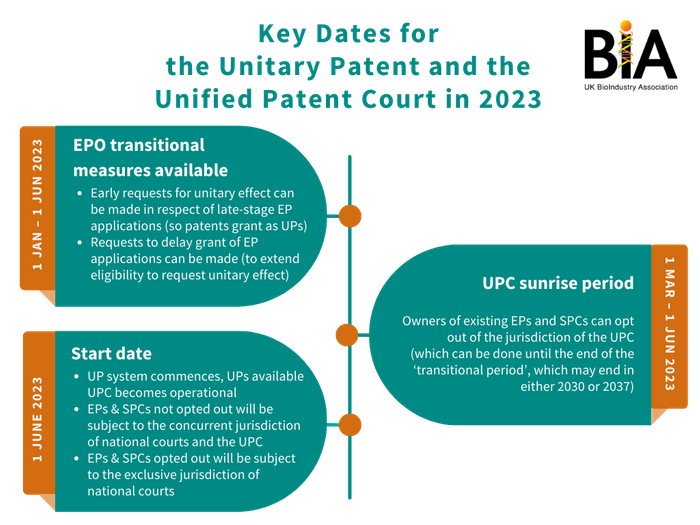Ready, Set, Patent? How to get ready for the Unitary Patent and the Unified Patent Court in 2023
Jodie Goonawardena (Powell Gilbert), Kate Hickinson (Appleyard Lees) and Tim Powell (Powell Gilbert) take a look at the implications of the new UP and UPC for BIA members and provide guidance on how to prepare for its launch.
The basics: The new Unitary Patent (UP) and Unified Patent Court (UPC)
A decade after the UPC Agreement was first signed, a new Unitary Patent (UP) will finally be launched in Europe. The launch date is currently expected to be 1 June 2023. The UP will cover all participating EU member states as a single patent, without the need for separate validations in each member state.
There will be 17 participating member states when the UP system starts:
Austria, Belgium, Bulgaria, Denmark, Estonia, Finland, France, Germany, Italy, Latvia, Lithuania, Luxembourg, Malta, Netherlands, Portugal, Slovenia and Sweden.
The EU member states Croatia, Cyprus, Czech Republic, Greece, Hungary, Ireland, Romania and Slovakia may later decide to participate, while Spain and Poland have indicated that they do not intend to do so. The UP will not cover the 12 non-EU states that are contracting states of the EPC, including the UK and Switzerland.
While the UP brings with it clear benefits, there are some less attractive attributes. Similar to national validations, a UP will be requested after grant. Some SMEs who request a UP will be able to claim financial compensation towards certain translation costs. In addition, validation and renewal costs may be lower compared to national validations if broad patent coverage in the EU is desired. However, the full renewal fee is payable for the lifetime of a UP, so it will not be possible to reduce renewal fees by abandoning certain states. Another potential issue with obtaining a UP is the current uncertainty over whether a Supplementary Protection Certificate (SPC) may be based on an UP – a matter yet to be resolved.
Alongside the launch of the UP, a Unified Patent Court (UPC) will be established with exclusive jurisdiction over all disputes relating to UPs. It will also have jurisdiction over existing European Patents (EPs) and SPCs in UPC member states, subject to an opt-out procedure. The UPC will comprise a Court of First Instance (being a local, regional or central division of the UPC) and a Court of Appeal (located in Luxembourg). Importantly, decisions of the UPC will have multi-jurisdictional effect; they will be binding in each UPC member state in which the relevant patent has effect, thereby removing the need to run parallel litigation in each of those jurisdictions.
Implications and how to prepare for launch
The new UP and UPC aim to simplify, standardise and centralise the patent system in Europe and offer a more efficient and cost-effective way to file and enforce patent rights. For the life sciences industry, the changes bring new strategic opportunities, including the potential to ‘clear the way’ to market entry across several jurisdictions at once. However, the new system may leave smaller companies more vulnerable, as the central revocation of their core patents could prove fatal to their business. Further, with these changes comes uncertainty, including as to how the relevant laws will be interpreted and applied by the UPC.
To prepare for the launch of UPs and the UPC, BIA members should, with their patent attorneys and lawyers, review their European patent portfolios and consider the following questions:
- Do you intend to hold patent rights in multiple participating UPC member states? If so:
- Are those rights covered by an existing EP application that is close to grant? (If so, consider whether to pursue grant of the patent as a UP and whether to delay grant to make this possible)
- Would the cost of obtaining and maintaining a UP be lower than that of a nationally validated EP or of separate local filings?
- Do you wish to retain the flexibility to let your patent lapse in some, but not all, participating member states? (If so, a UP may not be suitable)
- Do you hold any existing EPs or SPCs , that you do not wish to be subject to the jurisdiction of the UPC, e.g. to avoid risking multi-jurisdictional revocation? (If so, consider opting out of the UPC’s jurisdiction)
- Do you hold patent rights in participating member states via a licence? If so, check the licence to confirm your rights and responsibilities (including litigation responsibility) and consider whether the relevant provisions should be amended. Note that only the patent proprietor or applicant can opt out of the UPC’s jurisdiction and so it will be necessary to engage with them in any opt out strategy.
- If you are contemplating litigation in Europe in the next 6-12 months, consider the possibility of a UPC action as part of your strategy.

In considering these questions, members should be mindful of the following key dates:
- 1 January 2023 – 1 June 2023: EPO transitional measures available
- Early requests for unitary effect can be made in respect of late-stage EP applications (so patents grant as UPs)
- Requests to delay grant of EP applications can be made (to extend eligibility to request unitary effect)
- 1 March 2023 – 1 June 2023: UPC sunrise period
- Owners of existing EPs and SPCs can opt out of the jurisdiction of the UPC (which can be done until the end of the ‘transitional period’, which may end in either 2030 or 2037)
- 1 June 2023: Start date
- UP system commences, UPs available
- UPC becomes operational
- EPs & SPCs not opted out will be subject to the concurrent jurisdiction of national courts and the UPC
- EPs & SPCs opted out will be subject to the exclusive jurisdiction of national courts
.png)
.png)